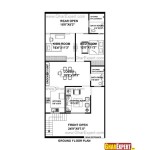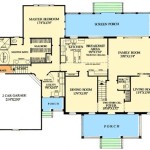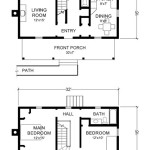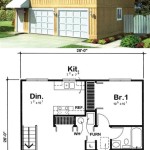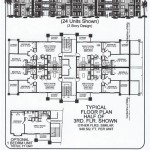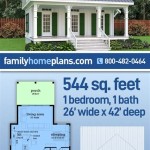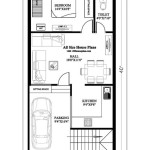House Plans With Underground Garage: Maximizing Space and Aesthetics
The integration of an underground garage into a residential house plan presents a unique solution for homeowners seeking to optimize space utilization, enhance curb appeal, and address challenging site conditions. This architectural approach involves constructing a garage beneath the main structure of the house or adjacent to it, often accessed via a ramp or elevator system. House plans incorporating underground garages require careful planning and execution, considering factors such as soil stability, drainage, ventilation, and local building codes.
The popularity of underground garages stems from a confluence of factors, including increasing land costs, the desire for minimalist aesthetics, and the need for secure and discreet vehicle storage. In densely populated urban areas, where space is at a premium, underground garages allow homeowners to maximize the usable area of their property without sacrificing parking space. Similarly, in areas with strict aesthetic guidelines or homeowners' association regulations, an underground garage can provide a subtle and unobtrusive way to accommodate vehicle storage without disrupting the overall architectural design.
Furthermore, underground garages can be particularly advantageous for properties with challenging topography, such as sloping lots or sites with restrictive setbacks. By excavating into the hillside or creating an underground structure, homeowners can overcome these limitations and create a functional and aesthetically pleasing living space. This type of design also allows for more landscaping opportunities above the garage, creating green spaces or gardens where a traditional garage would have been located.
Key Point 1: Design Considerations for Underground Garages
Designing a house plan with an underground garage necessitates meticulous attention to detail and a thorough understanding of various engineering and architectural principles. Several critical design considerations must be addressed to ensure the structural integrity, functionality, and safety of the garage.
One of the primary considerations is soil stability. Before commencing any excavation work, a comprehensive geotechnical investigation should be conducted to assess the soil's bearing capacity, drainage characteristics, and potential for settling or shifting. This investigation will inform the design of the foundation and retaining walls, ensuring that they can withstand the lateral earth pressure exerted by the surrounding soil. In areas with unstable soil conditions, soil stabilization techniques, such as soil nailing or retaining walls, may be required.
Another vital aspect is drainage. Effective drainage systems are essential to prevent water from accumulating around the foundation and potentially infiltrating the garage. This typically involves installing French drains, sump pumps, and waterproof membranes to divert water away from the structure. Proper grading and landscaping around the garage entrance can also help to channel water away from the building.
Ventilation is also crucial for an underground garage to prevent the buildup of harmful gases, such as carbon monoxide, which can be emitted by vehicles. A mechanical ventilation system should be incorporated into the design to ensure adequate air circulation and exhaust fumes. The system should be designed to meet local building code requirements for ventilation rates and air quality.
Furthermore, fire safety is a paramount concern. Underground garages should be equipped with fire-resistant materials, sprinkler systems, and smoke detectors to minimize the risk of fire and ensure the safety of occupants. Emergency egress routes and fire-rated doors should also be incorporated into the design to provide a safe escape path in the event of a fire.
Accessibility is another key consideration. The design should provide convenient and safe access to the garage for both vehicles and pedestrians. This may involve incorporating ramps, elevators, or staircases. Ramps should have a gentle slope to prevent vehicles from scraping the undercarriage, and they should be treated with a non-slip surface to enhance traction. Elevators should be designed to accommodate the size and weight of vehicles, and they should be equipped with safety features such as emergency brakes and backup power systems.
Key Point 2: Advantages of Underground Garages
The incorporation of an underground garage into a house plan presents several advantages that can enhance the functionality, aesthetics, and value of a property. These advantages include space optimization, improved curb appeal, enhanced security, and environmental benefits.
Space optimization is one of the most significant benefits. By locating the garage underground, homeowners can free up valuable surface space that can be used for other purposes, such as gardens, patios, or recreational areas. This is particularly advantageous in densely populated urban areas where land is at a premium.
Improved curb appeal is another notable advantage. Underground garages can enhance the aesthetic appeal of a property by eliminating the visual clutter of a traditional garage. This can create a more seamless and integrated appearance, allowing the house to blend harmoniously with its surroundings. The absence of a visible garage can also create a more inviting and welcoming entrance to the property.
Enhanced security is another compelling benefit. Underground garages can provide a more secure environment for vehicles and other stored items. By concealing the garage from view, they reduce the risk of theft and vandalism. The controlled access points, such as security gates or remote-controlled doors, further enhance the security of the garage.
Furthermore, underground garages can offer environmental benefits. By providing covered parking, they can help to reduce the heat island effect in urban areas. They can also help to protect vehicles from the elements, extending their lifespan and reducing the need for frequent maintenance. Additionally, the landscaping above the garage can help to absorb rainwater and reduce stormwater runoff.
The acoustic isolation provided by an underground garage can also be advantageous. The earth surrounding the garage helps to dampen sound, reducing noise pollution from vehicles and other equipment. This can create a more peaceful and quiet living environment for the occupants of the house.
Key Point 3: Construction Considerations and Cost Factors
Constructing an underground garage is a complex undertaking that requires specialized expertise and equipment. Several construction considerations and cost factors must be carefully evaluated to ensure the successful completion of the project within budget and on schedule.
Excavation is a critical step in the construction of an underground garage. The excavation process must be carefully planned and executed to ensure the stability of the surrounding soil and prevent damage to adjacent structures. Shoring systems, such as sheet piling or soldier piles, may be required to support the excavation walls. The excavated soil must be properly disposed of in accordance with local regulations.
Waterproofing is essential to prevent water from infiltrating the garage. Waterproofing membranes, coatings, and drainage systems should be installed to create a watertight barrier around the structure. The type of waterproofing system used will depend on the soil conditions, groundwater level, and building codes.
Structural support is crucial to ensure the long-term stability of the garage. The foundation and retaining walls must be designed to withstand the lateral earth pressure exerted by the surrounding soil. Reinforced concrete is typically used for the foundation and walls, and the design must comply with local building codes.
Ventilation and fire suppression systems are essential for the safety of the garage. A mechanical ventilation system should be installed to remove exhaust fumes and ensure adequate air circulation. A fire suppression system, such as a sprinkler system, should be installed to minimize the risk of fire. The systems must comply with local building codes.
The cost of constructing an underground garage can vary significantly depending on several factors, including the size of the garage, the soil conditions, the complexity of the design, and the location of the project. Excavation costs can be substantial, particularly in areas with hard rock or unstable soil. Waterproofing and structural support costs can also be significant. Overall, the cost of constructing an underground garage can be significantly higher than the cost of constructing a traditional above-ground garage.
Permits and approvals are required from local building departments before construction can begin. The permitting process can be lengthy and complex, and it may involve obtaining approvals from various agencies, such as planning departments, environmental agencies, and fire departments. It is essential to consult with local authorities to determine the specific permitting requirements for the project.
The selection of a qualified and experienced contractor is crucial for the successful completion of the project. The contractor should have experience in constructing underground structures and a thorough understanding of the relevant building codes and regulations. It is advisable to obtain multiple bids from different contractors and carefully evaluate their qualifications and experience before making a decision.

Hillside House Plans With Garages Underneath Houseplans Blog Com

This Is A Nice House Love The Underground Garage Idea Designs Exterior Facade Architecture

Plans Of A 1964 House In Mierendonk The Underground Garage Is Scientific Diagram

Drive Under House Plans With Basement Garage The Designers

Drive Under House Plans With Basement Garage The Designers

Drive Under House Plans

Simple House Floor Plans 3 Bedroom 1 Story With Basement Home Design 1661 Sf Ranch

Drive Under House Plans With Basement Garage The Designers

5 Amazing Houses With Underground Car Garage

Casa G By Ricardo Agraz Garage House Plans Modern Architecture Building Houses In Mexico

